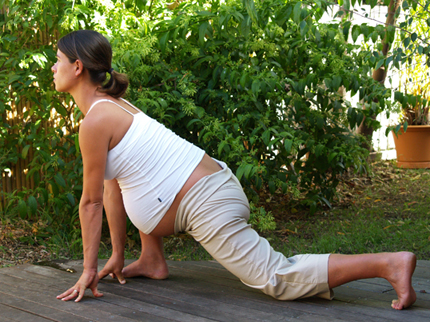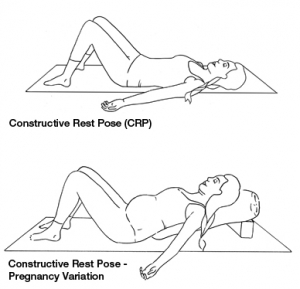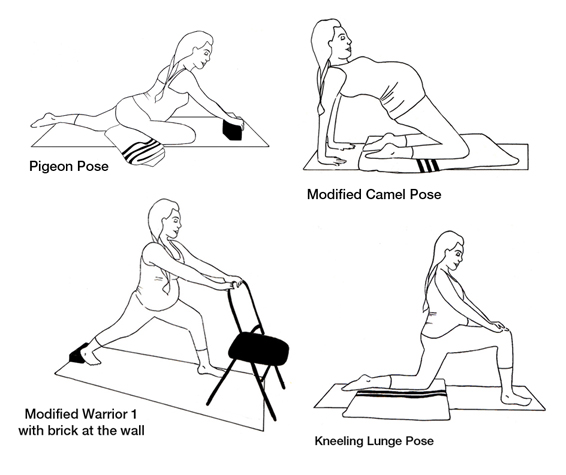 Bliss Baby Yoga Director and Founder, Ana Davis, shares beneficial postures for releasing the Psoas during pregnancy.
Bliss Baby Yoga Director and Founder, Ana Davis, shares beneficial postures for releasing the Psoas during pregnancy.
In our Bliss Baby Prenatal Yoga Teacher Training courses we teach that there are five important Posture Groups for a pregnant woman to practice for optimal health, vitality and balance during her pregnancy and to prepare for birth. One of these Posture Groups is what we call the ‘Releasing Postures.’ The idea behind these type of postures is that we want to release any aches and pains in a pregnant student’s lower back and hip area. During pregnancy, particularly the latter stages when her growing uterus has expanded well above the line of her navel, it is very common for her spine to be pulled into ‘lordosis’ or a kind of ‘banana back’, and for the top of her sacrum to tip forward. This is due to the weight of her enlarged belly pulling forward on the ligaments that support the uterus and essentially moving her whole centre of gravity forward and out of the natural vertical alignment.
This misalignment of her spine and pelvis can cause pain in her lower back and possibly also her sacrum. Our aim therefore with intelligent prenatal yoga practice is to help re-align her posture so that we can gently help to coax the weight of her belly back towards the spine so that it is naturally supported by the bones of the pelvis and not pulling on the belly or lower back. An analogy that well known Active birth proponent and author, Janet Balaskis uses is that we want the pregnant belly to be like an egg that is supported by the ‘cone’ of the pelvis. “This means you are holding your baby in position close enough to your spine, allowing your body weight (plus the weight of your uterus) to be transferred easily through your pelvis to your legs and feet, and to discharge to the ground,” writes Balaskis. This correct alignment not only helps relieve lower back and sacral pain but also positions the foetus optimally in preparation for birth, harnessing the energy of ‘apana’, the downward moving energy that is essential to facilitate birth – the movement of the baby out of the cervix and down and out of the birth canal.
One way to help a woman find more ease and support in her posture during pregnancy is to stretch those muscles that have been tightened and shortened due to this lordotic tendency. These are what we call the Releasing Postures. A key intention of these postures is to target and gently release the Psoas muscle. The Psoas muscle is a deep, core muscle that actually consists of a complex of muscles called the iliopsoas which connects the torso with the legs. It attaches from the twelfth thoracic vertebra on either side of the spine and runs through the very centre of body, passing through the pelvis and attaching to the inside of the thigh bone (lesser trochanter), and it also includes the iliacus which fans out on the inside of the pelvic basin. According to somatic therapist and psoas expert, Liz Koch the health and elasticity of our psoas is vital for a healthy, easeful pregnancy and birth. “If her psoas muscle is short and constricted, it reduces the internal space available for organs and viscera as well as the growing fetus,” writes Koch. Koch suggests that when a pregnant woman’s body is pulled by the growing uterus into misalignment – with her centre of gravity drifting too far forward – her sense of internal support becomes more dependent upon the muscles than the bones which can be experienced as “increased stress”. Koch argues that not only does releasing the psoas offer increased comfort for the pregnant woman but also supports the process of birth: “Once labor has begun, a functional iliopsoas releases and falls back along the spine, encouraging the downward movement of birth,” writes Koch. “The releasing iliopsoas frees the hip sockets and, thus, the legs move apart. As the iliacus fans open, the pelvic girdle widens and deepens.”
There is also the psycho-emotional factor at play when we consider birthing fear. Koch explains that the Psoas is actually associated with our fear response, our ‘fight of flight’ response elicited by the sympathetic nervous system – it naturally contracts and shortens when we are in a state of fear or nervous tension. Therefore, gently lengthening and relaxing her Psoas will also have the added benefit of working to release any birthing fear and bringing the pregnant and birthing woman into a more relaxed and trusting place – essential for the natural process of birth.
So how can we release the psoas during pregnancy?
We can passively release the Psoas in the resting position known as the Constructive Rest Position. This can be very beneficial to practice throughout her pregnancy as it subtly releases the Psoas by using gravity which offers the dual benefits of releasing lower back tension and calming the nervous system. During First Trimester, the woman can practice the classic variation of Constructive Rest Position (CRP).
To practice CRP lie on your back with your legs bent up, feet the distance of your hip sockets and parallel. Have the feet a comfortable distance from the buttocks – not too close or far away. The idea is that the pelvis should be parallel to the floor – neither tipped forward or back – and you are honouring the natural curves of the spine. You can have a low support under the head as long as the head and neck are in line with the spine and your head is neither tipped too far forward or back. Rest here for 5 – 20 minutes, breathing deeply into your belly.
From second trimester onwards, as our belly grows it is no longer advisable to spend prolonged periods lying on our back, so practice the adapted version for pregnancy with the torso supported on an inclined bolster.
 Other Psoas-releasing postures that are beneficial to practice throughout pregnancy are the Pigeon Pose, Modified Camel Pose, Modified Warrior 1 with a brick at the wall, and the Kneeling Lunge Pose. For the Kneeling Lunge pose, rather than make it a big action where you lunge your front knee deeply forward, modify it by staying more upright, with your hands pressed into your front, right thigh. Tuck your tail-bone under, engaging the gluteal muscles of the back, left leg, to help really target and release into the front of the left groins, lower Psoas area. Only once you’ve switched on the glutes of the rear leg and tucked the pelvis into more of posterior-pelvic tilt, should you lunge your front knee more deeply into the pose.
Other Psoas-releasing postures that are beneficial to practice throughout pregnancy are the Pigeon Pose, Modified Camel Pose, Modified Warrior 1 with a brick at the wall, and the Kneeling Lunge Pose. For the Kneeling Lunge pose, rather than make it a big action where you lunge your front knee deeply forward, modify it by staying more upright, with your hands pressed into your front, right thigh. Tuck your tail-bone under, engaging the gluteal muscles of the back, left leg, to help really target and release into the front of the left groins, lower Psoas area. Only once you’ve switched on the glutes of the rear leg and tucked the pelvis into more of posterior-pelvic tilt, should you lunge your front knee more deeply into the pose.
As you do all of these postures, try working with deep ‘falling-out breaths’ (releasing the exhale through an open, relaxed mouth), consciously breathing out and away any tension in the deep core, psoas and hip flexor muscles.
Practising these passive and more active psoas-releasing postures offers a balanced approach to your prenatal yoga practice and hopefully provides the pregnant woman with a more joyful, easeful and relaxed pregnancy and birth experience.
References
- Balaskis, Janet, “Preparing for Birth with Yoga”
- Koch, Liz, “The Psoas Book”
- Koch, Liz, “Pregnancy and the Psoas Muscle” published in “The Doula Magazine”, 1988
- Koch, Liz, “Birthing Fear: The Iliopsoas Muscle,” published in “Midwifery Today,” 2005
- Davis, Ana, “Bliss Baby Yoga Prenatal Teacher Training Manual”, 2015
 Ana Davis is the Director and Founder of Bliss Baby Yoga – specialising in yoga for women, including yoga for Pregnancy, Postpartum and Mums n Bubs, Fertility, Menstruation, Menopause, Restorative Yoga, and more.
Ana Davis is the Director and Founder of Bliss Baby Yoga – specialising in yoga for women, including yoga for Pregnancy, Postpartum and Mums n Bubs, Fertility, Menstruation, Menopause, Restorative Yoga, and more.